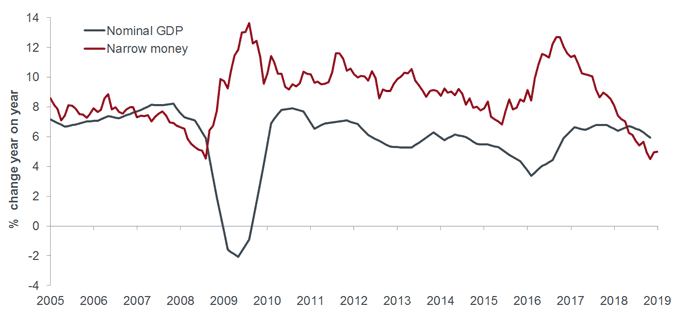How did they miss it? Central bankers and the global economic downturn…

Jenna Barnard, Co-Head of Strategic Fixed Income, explains how and why so many major central banks have been wrong-footed on economic growth in their countries and around the globe.
A counter-intuitive speech…
At lunchtime, on 5 November 2018, Governor Poloz of the Bank of Canada stood up in front of a crowded hotel audience in London to give a speech entitled “Making Sense of Markets”. The purpose of this speech was to “consider some of the market action we have seen in 2018” (which included a c.14% drop in oil in the prior month, a flattening of the yield curve 1 and the beginning of the downturn in equities) and attempt to reconcile this with the benign, some would say rosy, outlook for growth that the Bank of Canada and other central banks continued to propound.
It is particularly notable that the Bank of Canada at the time was threatening to accelerate the speed of its rate rising cycle. At the time, we were stunned by this speech as it exhibited to us a profound misunderstanding of markets and in our view, an inability to read the signals being sent by various asset classes. In addition, it was already clear that the ‘softening’ in the global economy was turning into something far more ‘pronounced and pervasive’.
…echoed by other central banks…
This mistake was replicated throughout the central banking community in the final months of 2018. At a conference in London on 13 November, we heard Peter Praet, the Chief Economist of the European Central Bank (ECB), blame one-off factors for the Q3 collapse in eurozone growth and forecast a rebound in Q4. He did at least acknowledge that having previously thought the slowdown was caused by supply constraints, the bank could now see that demand 2 was the problem and the slowdown was internationally driven. Nevertheless, he breezily stated that financial conditions ‘remain very easy’ and specifically downplayed the terrible performance of European banking share prices during the course of 2018. Meanwhile, the Bank of England threatened to hike interest rates, even in a scenario of a disorderly/hard Brexit and the US Federal Reserve (Fed) claimed interest rates were far from neutral 3 at a time when interest rate sensitive sectors such as housing and autos were decelerating fast.
…which we found baffling
Even for a bond fund manager used to the unyielding models of orthodox economists and central bankers, Governor Poloz’ speech appeared extraordinary and deeply counter-intuitive to us. He concluded that financial markets “…do not point to a gloomy economic outlook by any means — rather, they are welcome symptoms of [interest rate] normalization”.
In doing so, Governor Poloz confidently asserted two things:
- That his interpretation of government bond markets was that they were signalling the end of deflation and the beginning of reflation: “…a decade of massive monetary policy intervention is finally taking the risk of deflation off the table… it seems that the more important signal coming from the bond market is not a flattening of the yield curve, but the reversal in the longstanding downward trend in long-term yields4”…</”…
- We disagree — the flattening of all yield curves, most pronounced in Canada, was a strong and consistent signal that the bond market saw a late-cycle 5 economic environment and warned central bankers against autopilot rate rises.
- … and that as a result, “our forecast [for growth] is a positive one. We project the economy will continue to operate close to its capacity limits, with annual growth around two per cent over the next couple of years.”
Reality bites
Fast forward to today, and the incoming data shows that gross domestic product (GDP) growth almost ground to a halt in Canada during the final quarter of 2018, as it has in a number of developed economies. GDP fell in three of the final four months of 2018; including back-to-back declines in November and December, dragged down not only by the oil sector but also a dramatic weakening in household spending.
None of this should have been a surprise; the combination of record high household debt, a housing market correction and the cumulative impact of five previous rate hikes provided a challenging backdrop.
In Australia, a similar household retrenchment has occurred amid a property market correction and severe tightening in credit conditions, following an investigation of egregiously loose bank lending standards. Again, the Reserve Bank of Australia (RBA) missed this slowdown, based on a belief that there was little or no wealth effect from falling house prices.
With the data now reported we can see that in the second half of 2018 the Australian economy had just entered its first per capita GDP recession since 2009. We had flagged both economies as at risk in this note from March 2018: Australia, Canada and Sweden: save the last dance for me.
And now come the U-turns
This raises the question of how and why? Since early 2019, central banks have executed sharp U-turns in their policy guidance with the Fed entirely reneging on its December 20th press conference guidance relating to the ‘autopilot’ nature of balance sheet rundown.
The RBA now says the next move in interest rates may be down (previously said up) and the ECB has just extended unchanged rates guidance to mid-2020 and launched a new round of liquidity facilities for the banking sector. Meanwhile, the Bank of Canada no longer issues guidance for rate hikes in early 2019 and ponders what they missed in the household sector. This pragmatism is welcome but raises the issue of intellectual blind spots and misreading of financial markets.
Clearly, for economists, a perennial problem is the continued emphasis on lagging economic data (specifically reported unemployment rates), which creates a natural inclination to be late in diagnosing the slowdown. Not everyone in the economics community is subject to this bias but central banks are particularly susceptible.
It’s Japan all over again
In addition, we have written and spoken on numerous occasions over the last seven years about the lessons from Japan in terms of debt cycles and demographics. The key lesson was the relative impotence of monetary policy in these scenarios: lowering interest rates does not stimulate the economy in the way that traditional economic models would suggest. Fiscal stimulus was necessary, albeit not sufficient, to generate respectable growth. Orthodox economic models of economies fail to adequately take into account the disruption of long-term structural factors 6 like these, in addition to the impact of technology, inequality and other factors, which create the ‘climate’ for both economic performance and investments.
The climate has decisively changed since the Global Financial Crisis (GFC) in our view and yet the slow pace of adaptation among economists and fund managers alike, as well as an excessive focus on the ‘weather’ (cyclical ups and downs), create the wrong dialogue and thought process. A greater openness of thinking in this community can only enhance the outcome and ward against blind spots in our view.
[caption id=”attachment_144565″ align=”alignnone” width=”680″] Source: Simon Ward, Economic Adviser, Thomson Reuters Datastream, January 2005 to March 2019 Note: GDP: gross domestic product E7 or Emerging 7: China, India, Brazil, Mexico, Russia, Indonesia and Turkey G7: Canada, France, Germany, Italy, Japan, the UK and the US[/caption]
Source: Simon Ward, Economic Adviser, Thomson Reuters Datastream, January 2005 to March 2019 Note: GDP: gross domestic product E7 or Emerging 7: China, India, Brazil, Mexico, Russia, Indonesia and Turkey G7: Canada, France, Germany, Italy, Japan, the UK and the US[/caption]
The power of M1
One heterodox form of economics, which has proved particularly prescient in recent years and which we utilise, is a focus on monetary and credit data. We continue to highlight the monetarist work of Simon Ward, our Economic Adviser. He has proved remarkably accurate at forecasting inflection points in the global growth cycle with trends in real M1 leading economic data by approximately nine months.
The focus on real M1 (narrow money)* is rejected by central bankers. But perhaps in the debt-soaked world we live in, so reliant on liquidity injections from central banks, a renewed focus on monetary growth might be a natural supplement, or challenge, to orthodox economic thinking.
In the chart below you can clearly see the synchronised collapse in narrow money in 2017 that foreshadowed the global downturn in 2018. Simon supplements this analysis with ‘cycles’ theory, the idea that there is a natural rhythm to business cycles, in particular manufacturing inventory cycles, the likes of which we are seeing today.
Chart: synchronised collapse in narrow money
An unfashionable idea that is evidently true
Time-based economic forecasting is unfashionable. Until the mid-twentieth century, economists were sympathetic to the idea that business activity and prices fluctuate in regular cycles: inventory cycles, business investment cycles, etc. The majority view today is that booms/busts reflect policy errors, market failures or supply-side shocks; cycles still occur but they are unpredictable. The behaviour of the global economy in recent years, however, has been explicable in terms of the old fixed length cycles providing challenge to the consensus view.
The future model
Old economic models are breaking down and central banks are searching for a new intellectual framework. With the recent downplaying of the Phillips Curve 8 from the Fed and the appearance of targeting financial markets, a gap has emerged for central banks to challenge their models and no doubt, tweak their targets.
The best decision we made as bond managers was to mentally throw away our economic textbooks in 2011 and instead, teach ourselves about the ‘apparent aberration’ that was the Japanese economic experience of previous decades.
The mental leap continues to enhance our duration management and expose the fault lines of much of the traditional economic research we receive in our inbox. Now, as we reach the limits of monetary policy in a number of developed economies, a greater degree of experimentation and coordination with fiscal policy looks likely. The burden on monetary policy alone to drive cycles will diminish, and with it perhaps, the pretence that central bankers have the exclusive ability to “Make sense of markets” and economies.
*Narrow money = currency in circulation plus demand/overnight deposits. Real = deflated by consumer prices.
Glossary
1 Flat yield curve: a normal yield curve (a graph that plots the yields of similar quality bonds against their maturities) is upward sloping, where longer maturity bond yields are higher than short-term ones. In a flat yield curve the difference between long term and short term bond yields almost disappears. A flat yield curve is typically an indication that investors are worried about the macroeconomic outlook.
2 Supply constraint: within an economy ‘demand’ is the quantity people want to buy and ‘supply’ is the quantity people want to sell. Supply constraints simply means that production in the economy is unable to keep pace with rising demand due to a variety of factors such as inadequate infrastructure, lack of credit, availability of labour and availability of technology.
3 Neutral rate: the rate at which monetary policy is neither contractionary nor expansionary; this is a rate that should exist when an economy is at full employment and has stable inflation. The neutral rate cannot be observed directly; it can only be estimated. It matters because it affects how central banks judge whether the interest rates they set are stimulating or restraining the economy. By setting their benchmark rates above or below the neutral rate, they can cool or stimulate the economy. The neutral rate is essentially a guidepost for monetary policy.
4 Yield: the level of income on a security, typically expressed as a percentage rate.
5 Late-cycle: asset performance is often driven largely by cyclical factors tied to the state of the economy. Economies and markets are cyclical and the cycles can last from a few years to nearly a decade. Generally speaking, early cycle is when the economy transitions from recession to recovery; mid-cycle is when recovery picks up speed while in the late cycle excesses typically start to build, growth slows, wages start to rise and inflation begins to pick up. At this stage, investors become invariably bullish believing that prices will continue to rise.
6 Structural factors: an economic condition arising when an industry or market changes how it functions or operates. This could be attributed to new economic development, shifts in the pools of capital and labour, demand and supply of natural resources, political and regulatory change, taxation, etc.
7 M1 Narrow money = currency in circulation plus demand/overnight deposits. Real = deflated by consumer prices.
8 Phillips Curve: the Phillips curve represents the long-term relationship between unemployment and inflation in an economy. An inverse but stable relationship between wage inflation and unemployment, the curve implies that changes in the level of unemployment would have direct and predictable effects on wage inflation. It is used to analyse macroeconomic policy.
These are the views of the author at the time of publication and may differ from the views of other individuals/teams at Janus Henderson Investors. References made to individual securities do not constitute a recommendation to buy, sell or hold any security, investment strategy or market sector, and should not be assumed to be profitable. Janus Henderson Investors, its affiliated advisor, or its employees, may have a position in the securities mentioned.
Past performance does not predict future returns. The value of an investment and the income from it can fall as well as rise and you may not get back the amount originally invested.
The information in this article does not qualify as an investment recommendation.
Marketing Communication.
